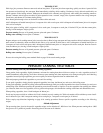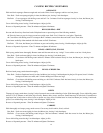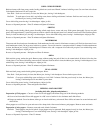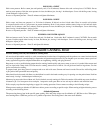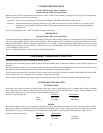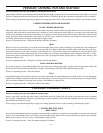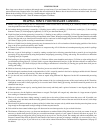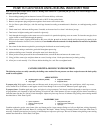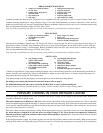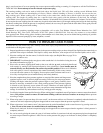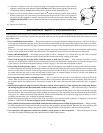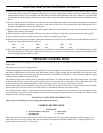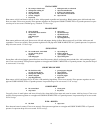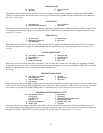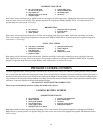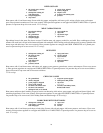
19
BREAD AND BUTTER PICKLES
4 pounds 4- to 6-inch cucumbers, 2 tablespoons mustard seed
cut into slices 2 teaspoons turmeric
2 pounds onions, thinly sliced 2 teaspoons celery seed
(about 8 small) 1 teaspoon ginger
1
⁄
3
cup canning salt 1 teaspoon peppercorns
2 cups sugar 3 cups vinegar, 5% acidity
Combine cucumber and onion slices in a large bowl. Layer vegetables with salt; cover with ice cubes. Let stand 1½ hours. Drain; rinse.
Combine remaining ingredients in a large saucepot; bring to a boil. Add drained cucumbers and onions and return to a boil. Pack hot
pickles and liquid into hot jars, leaving ¼-inch headspace. Remove air bubbles. Adjust two-piece caps. Process 10 minutes using boiling
water canning method described on page 18. Yield: about 7 pints.
Note: For fresh pack pickled foods, allow 4 to 6 weeks for the product to cure and develop a satisfactory flavor.
DILL PICKLES
8 pounds 4- to 6-inch cucumbers, 1 quart vinegar, 5% acidity
cut lengthwise into halves 1 quart water
¾ cup sugar 3 tablespoons mixed pickling spices
½ cup canning salt Green or dry dill (1 head per jar)
Wash and drain cucumbers. Combine sugar, salt, vinegar, and water in a large saucepot. Tie spices in a spice bag; add spice bag to vin-
egar mixture; simmer 15 minutes. Pack cucumbers into hot jars, leaving ¼-inch headspace; put one head of dill in each jar. Ladle hot
liquid over cucumbers, leaving
1
⁄
4
-inch headspace. Remove air bubbles. Adjust two-piece caps. Process pints 15 minutes using boiling
water canning method described on page 18. Yield: about 7 pints.
Note: For fresh pack pickled foods, allow 4 to 6 weeks for the product to cure and develop a satisfactory flavor.
ZESTY SALSA
10 cups chopped, seeded, 2½ cups chopped and seeded hot
peeled, cored tomatoes peppers (about 1 pound)
(about 6 pounds) 1¼ cups cider vinegar
5 cups chopped and seeded long 3 cloves garlic, minced
green peppers (about 2 pounds) 2 tablespoons cilantro, minced
5 cups chopped onions (about 1 tablespoon salt
1½ pounds) 1 teaspoon hot pepper sauce (optional)
Combine all ingredients in a large saucepot, adding hot pepper sauce, if desired. Bring mixture to a boil. Reduce heat and simmer 10
minutes. Ladle hot salsa into hot jars, leaving ¼-inch headspace. Adjust two-piece caps. Process 15 minutes using boiling water can-
ning method described on page 18. Yield: about 6 pints.
Note: When cutting or seeding hot peppers, wear rubber gloves to prevent hands from being burned.
For boiling water canning information for fruits and tomatoes, refer to page 8.
For additional information and recipes, consult the Ball Blue Book or visit www.homecanning.com.
Recipes provided by Alltrista Consumer Products Company, marketers of Ball
and Kerr
home canning products.
PRessuRe CooKinG in YouR PRessuRe CanneR
Follow the step-by-step instructions (see “How To Pressure Cook Foods” on page 20) for cooking in your pressure canner. Prepare food
according to directions in specific recipe.
The canner should never be filled over
2
⁄
3
full. Many foods tend to expand when cooked. If the canner is filled over
2
⁄
3
full, it is possible
for food to expand enough to plug the vent pipe, air vent/cover lock, and overpressure plug. If all of these devices were to become blocked,
excess pressure would be unable to escape and would build up beyond safe control levels. Therefore, when cooking any food, do not let
any portion extend above the
2
⁄
3
full level.
Rice and dry beans and peas expand during cooking. When preparing these foods, do not fill the canner over ½ full. Always pre-soak
dry beans and peas overnight in oil, salt, and water (see recipes on pages 27-28). Never pressure cook applesauce, cranberries,
rhubarb, pearl barley, split peas, oatmeal or other cereals, dried soup mixes, or pasta. These foods tend to foam, froth, and sputter
and may block the vent pipe.
If the vent pipe becomes clogged, the pressure regulator will not rock and pressure cannot be released normally. When excess pressure
builds up in the canner, the overpressure plug will be forced out of its cover opening, releasing the excess pressure. If the overpressure



